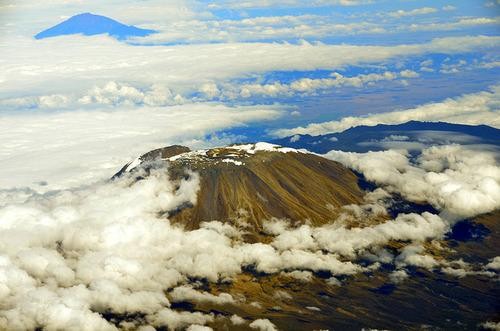I don’t want to be the one to
tell you this, but the sad truth is that nothing truly lasts forever.
The sea levels are rising, glaciers are melting, rain forests are being
chopped down, and climate change is no longer just the plot of a
disaster movie starring John Cusack. Things move pretty fast these days.
If you don’t put these gems on your must-see list, you could miss them
altogether. And frankly, we don’t want to be responsible for your FOMO.

Kilimanjaro from above. (Photo: Ben Freeman)
1. Kilimanjaro’s Snow-Capped Peaks: As
far as travel brags go, that iconic photo of you atop the snow-capped
peak of Uhuru Summit on Mt. Kilimanjaro is a solid. Sadly, that shot is
about to get way less awesome now that all of the snow is melting. More
than 85 percent of the ice cap has disappeared in the last century and
it could be completely gone within the next 20 years.
Fun fact: It takes the average Joe between six and nine days
to summit Kilimanjaro, depending on which of the six routes they choose.
The Details:
Climbing requires hiring a licensed guide and will typically cost
between $1,000 and $5,000, including food and accommodations on the
mountain. It helps to plan at least six months, if not a year, in
advance. We recommend Thomson Treks for their knowledgeable guides and stellar summiting success rate.
The crystal waters of the Maldives. (Photo: Rom)
2. The Maldives: Perched precariously 1.5 meters above sea level, the Maldives could soon become a real-life Atlantis. President Mohamed Nasheed has already warned world leaders that if greenhouse gases are not reduced soon, this island chain in the Indian Ocean will be swallowed up by the sea, which means you’ll never experience their bone-white beaches, crystal-clear waters, and turquoise reefs.
Fun fact: The Maldives are one of the few places on earth where you can swim with whale sharks year round. They tend to stick to the western side of the archipelago from May to December, then head east for the rest of the year.
The Details: The Maldives Whale Shark Research Programme runs weekly, year-round snorkeling and scuba trips where you can actually swim with the world’s largest fish.
3. The Unspoiled Beaches of Culebra: Known to locals as Ultima Virgen (The Last Virgin), Culebra is the quieter kissing cousin to Vieques. Today this small island of Puerto Rico remains relatively undeveloped. Unfortunately, that probably won’t last much longer. Plenty of large hotel chains are turning their gaze onto the tiny island, with its perfect beaches and magnificent coral reefs. Go now to savor the remaining years of its truly rustic beauty.
Fun fact: Flamenco Beach is widely considered one of the most beautiful beaches in the world, but it is worth a walk to some of the sleepier beaches the island has to offer, like Melones. A local favorite, this coral beach is an easy walk from town.
The Details: Hotels are few and far between, and you will be better off renting out a private home. Reach out to the folks at Culebra Island Realty to try to find something in your price range.
(Photo: National Ocean Service)
4. Arctic Polar Bears in the Wild: When I told our editor-in-chief that I was going to plan a trip to northern Canada see the polar bears in the wild ASAP, she grew concerned for me. “I can just see the headline of the New York Post now: ‘Travel Editor Mauled to Death Trying to Hug a Polar Bear’.” She isn’t wrong. But these magnificent carnivores are becoming so few and far between that spotting a polar bear in the Arctic Circle is already akin to seeing a unicorn. Just ask Al Gore.
Fun fact: Churchill is only accessible by plane or train, making it incredibly remote—and incredibly awesome.
The Details: Absolutely everything is charming about the handcrafted log building that is the Lazy Bear Lodge. This hotel will happily arrange all of your bear-peeping activities. Summer is the best time to go, since the polar bears are all leaving the pan ice and the temperatures are less frigid.
Fun fact: With two-thirds of the world’s polar bears possibly going extinct by 2050, it is high time you booked a trip to Churchill, Canada, the self-proclaimed Polar Bear Capital of the world.
5. Glacier National Park: A century ago, there were more than 150 glaciers in Northern Montana. Today only 27 remain and even those could disappear within the next 15 years. When the naturalist John Muir visited the park at the turn of the 20th century, he wrote: “Get off the tracks at Belton Station [now West Glacier] and in a few minutes you will find yourself in the midst of what you are sure to say is the best care-killing scenery on the continent.” He is right. Even without the glaciers, the views would be nothing short of spectacular, but they add frosting to an already amazing cake.
Fun fact: One of the best ways to see the park is by horseback.
The Details: Swan Mountain Outfitters offers a variety of riding options, which you be paired with rafting and fly fishing for an overnight saddle-paddle adventure.
6. Maria von Trapp’s Austrian Mountain Range: The snow line in the Alps is receding faster than Sting’s hairline. It has moved 200 feet in the past 50 years alone. Where the hills were once alive with the sound of music, climate change and reduced snowfall is destroying Austria’s gorgeous high-altitude flowers, among them Edelweiss.
Fun fact: Edelweiss actually originated in the Asian Steppe, but it is now most often found at an altitude of 1,700 meters in German, Italy and Austria.
The Details: Visit the picturesque village of Zell Am See in the heart of the Leogranger Steinberge Alps to take in the views from the top of Kitzsteinhorn and over the glacier. For the classic old-school Alp experience, check into the Grand Hotel Zell Am See on its own private peninsula on the shore of Lake Zell.
(Photo: Meg and Rahul)
7. The Taj Mahal:
More than three million visitors a year currently visit the iconic
mausoleum built in the 17th century in memory of the emperor Shal
Jahan’s favorite wife. See it while you still can. In recent years, cars
were banned from driving close to the Taj because of pollution (tip:
take a donkey ride the remaining distance). And some preservation groups
are pushing to close the landmark since all that foot traffic is
seriously eroding the structure.
Fun fact: Dawn is the best time to see the Taj. Or ask a taxi
driver to bring you across the river, where you can view the back of
the temple at dusk.The Details: If you want a room with amazing views of the Taj, book with Oberoi Amarvillas, just 600 meters from the monument.
8. The Tigers of Rajasthan: It is a distinct and incredibly unsettling possibility that the tiger could become extinct in our lifetime. Their natural habitats have been reduced by 93%. In 1900, some 100,000 tigers lived in India. Today, as few as 3,200 remain.
Fun fact: In 2012, the Indian Supreme Court ruled that no new tourist attractions can be created in the tiger areas and that only 20% of the tiger habitats can be open to visitors.
The Details: Ranthambore National Park
is the best place to spot tigers in the wild and there’s no shortage of
tour operators eager to take you on a safari. That said, the scarcity
of tigers, even in the sanctuary, means that a sighting isn’t
guaranteed. Make sure to book two to three days in the area. Ask for the
smaller six-seater jeep (less intrusive in the tiger habitat) directly
through the national park.
(Photo: Paul Vladuchick / Flickr)
9. The Yangtze River Basin:
The ongoing construction of China’s $24 billion Three Gorges Dam is
posing a serious threat to the wildlife of the Yangtze River basin,
including the giant pandas, Yangtze finless porpoises (known in Chinese
by the very excellent name the “river pig”), and dwarf blue sheep—so
rare I’m not even sure what they are, but I definitely want to see them
before they disappear.
Fun fact: Thirteen years ago, the Panda Breeding Research Base
in the river basin was home to only 20 pandas. Advancements in
insemination technology have since grown that population to more than
100.
The Details: A
trip to "panda kindergarten" is one of the greatest gifts you could ever
give yourself. Trust me. I gave it to myself in 2009 when I travelled
to the city of Chengdu with the sole intent and purpose of cuddling a
baby panda. I accomplished this goal (and you can too) at the Panda
Breeding Research Base, where it costs about $100 for 90 seconds of
blissed-out panda snuggling.
Original article at: 9 Things You Must See Before They Disappear Forever
By:
Apr 26, 2014

No comments:
Post a Comment